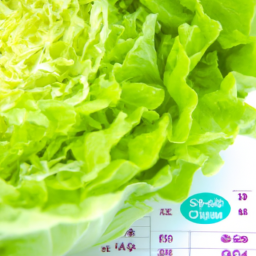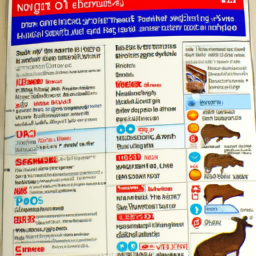Celeriac: A Refreshing and Nutritious Addition to Your Diet
Celeriac, also commonly called celery root, knob celery, and turnip-rooted celery, is a nutritious vegetable worth adding to your diet. It has a flavor similar to regular celery and carrots, and can be enjoyed cooked or raw in many dishes.
Nutritional Benefits
Celeriac has a great nutritional profile. It is packed full of Vitamin K, Vitamin C, and dietary fiber. It is also a great source of folic acid and other essential vitamins and minerals like thiamin, potassium, and magnesium. Eating celeriac on a regular basis can help keep your immune system functioning well while promoting healthy muscle growth and aiding cognitive development.
Tasty Ways to Enjoy Celeriac
There are many delicious ways to include celeriac in your diet. Here are a few of our favorites:
- Roasted celeriac: Cut a celeriac bulb into 1-inch cubes. Coat cubes with olive oil, salt and pepper, and roast in the oven at 425 degrees until golden and crispy. Enjoy as a side dish or top with your favorite vegetables for a heartier meal.
- Celeriac chips: Slice a celeriac bulb into thin slices. Coat with olive oil. Arrange on a baking sheet and bake in the oven until golden and crispy. Enjoy as a crunchy snack or as a topping on salads or tacos.
- Celeriac soup: Sautee onion, garlic, and celeriac in some oil until softened. Add vegetable broth and simmer for 20-30 minutes. Puree with an immersion blender until smooth. Serve hot with a dollop of creme fraiche.
Conclusion
Celeriac is a delicious, nutritious vegetable that can easily be added to just about any dish. Try some of the ideas above and make celeriac a refreshing and nutritious addition to your diet!
What are some ways to cook celeriac?
1. Roast: Preheat oven to 375F. Peel and cut celeriac into 1-inch cubes. Toss with olive oil, salt, and pepper over a baking tray. Roast in oven for 35-45 minutes, stirring once or twice.
2. Boil: Peel and cut celeriac into 1-inch cubes. Boil in salted water for 8-10 minutes until tender. Serve as a side.
3. Mash: Peel and cut celeriac into 1-inch cubes. Boil in salted water for 8-10 minutes until tender. Drain, mash and mix with butter, cream, and seasoning.
4. Fry: Peel and cut celeriac into 1-inch cubes. Heat oil in a pan and, working in batches, cook cubes until golden and tender.
5. Soup: Heat oil in a pot and sauté diced onion. Add celeriac and other vegetables of your choice, season with salt and pepper, and sauté for a few minutes. Add stock and herbs, bring to a boil, and simmer for 20 minutes. Purée using a hand blender and serve.
6. Gratin: Peel and cut celeriac into thin slices. Spread in a greased baking dish. Top with cream, cheese, and breadcrumbs. Bake in preheated oven at 375F for 25-30 minutes.
What is the best way to prepare celeriac?
The best way to prepare celeriac is to peel and cube it. Once the celeriac is prepped, it can be boiled, steamed, roasted, sautéed, mashed, or used to make soups and purées. It can also be eaten raw by shredding or grating it into salads and dishes.
What is the nutritional value of celeriac?
Celeriac contains a range of essential vitamins and minerals, including Vitamin C, Vitamin K, phosphorus, magnesium, zinc, and dietary fiber. It is also an excellent source of potassium (450 mg per 100 g) and contains several B vitamins including thiamine and riboflavin. Celeriac is low in calories and contains no fat or cholesterol.
What are the health benefits of eating celeriac?
1. Improved Digestion: Celeriac is a good source of dietary fiber, which helps to keep food moving through the digestive system. This can help to prevent constipation, reduce your risk of developing gastrointestinal issues, and aid in overall digestive health.
2. Heart Health: Celeriac is rich in potassium and low in sodium. This makes it beneficial for those trying to reduce their risk of high blood pressure and other heart-related diseases.
3. Bone Health: Celeriac is high in phosphorus, a mineral that plays a key role in the development and maintenance of strong bones. Celeriac is also an excellent source of vitamin K which has been shown to improve bone density and reduce the risk of fractures.
4. High Nutrient Content: Celeriac also contains an array of vitamins and minerals, such as vitamin C, magnesium, and iron.
5. Diabetes Management: Celeriac is a low glycemic index food, which means it breaks down slowly and thus helps to maintain blood sugar levels. This can help to manage the symptoms of diabetes.
6. Weight Management: Celeriac is low in calories and high in dietary fiber, which makes it an excellent choice for those trying to lose or maintain a healthy weight.
What is the nutritional value of celeriac?
Celeriac is a low-calorie vegetable that provides an excellent source of dietary fiber and antioxidants. It contains a large amount of vitamin K, which helps in the maintenance of bone health, and vitamin C, which helps to support the immune system. It is also a source of potassium, magnesium, and calcium. Celeriac is low in saturated fat, cholesterol, and sodium. One cup (150 grams) of raw celeriac provides:
•Calories: 39
•Protein: 1.2 grams
•Carbs: 8.6 grams
•Fiber: 2.8 grams
•Fat: 0.2 grams
•Vitamin C: 12% of the RDI
•Vitamin K: 39% of the RDI
•Potassium: 10% of the RDI
•Magnesium: 8% of the RDI
•Calcium: 1% of the RDI
Adding variety to your diet is one of the best ways to keep it interesting, and the humble vegetable Celeriac is one of the more unusual options with loads of health benefits. Known by many as the turnip-rooted celery, Celeriac is an under-utilized vegetable with a mild and nutty flavor.
This versatile veggie can be enjoyed raw or cooked, in slaws, fritters, soups, curries — and even the traditional French dish “Celeriac Rémoulade.” Celeriac is packed with essential vitamins and minerals, as well as dietary fiber, meaning it can be a healthy and nutritious addition to any diet.
Celeriac is an excellent source of vitamin K, an important nutrient for blood clotting and bone health. It also contains a good amount of folate, vitamin C, and vitamin B6, which are important for a healthy immune system and for cell growth. Additionally, Celeriac is an excellent source of potassium, an essential mineral for healthy blood pressure.
In terms of flavor, Celeriac has a very mild and nutty taste. It can be enjoyed raw, sliced and scattered with salads, or boiled and mashed to be used as a low-carb alternative to mashed potatoes. It is also popularly used in a variety of French dishes, including Soupe à l’orange (a type of carrot and celeriac soup) and the classic Celeriac Rémoulade, a raw salad made with grated Celeriac and mayonnaise.
Celeriac is a healthy and nutritious vegetable that can help add variety and flavor to your diet. Its mild taste stands out in both savory and sweet dishes, and it can be a great alternative to potatoes, or to the same basic vegetables used all the time. So, don’t be afraid to give this unique and refreshing veggie a try – you may surprise yourself!





No Comments